Metallic 2H-Tantalum Selenide Nanomaterials as Saturable Absorber for Dual-Wavelength Q-Switched Fiber Laser
Abstract
1. Introduction
2. Band Structure and Characterization of TaSe2-SA
3. Experimental Setup
4. Results and Discussion
5. Conclusions
Author Contributions
Funding
Institutional Review Board Statement
Informed Consent Statement
Data Availability Statement
Conflicts of Interest
References
- Xian, T.; Zhan, L.; Gao, L.; Zhang, W.; Zhang, W. Passively Q-switched fiber lasers based on pure water as the saturable absorber. Opt. Lett. 2019, 44, 863–866. [Google Scholar] [CrossRef] [PubMed]
- Wang, Z.Q.; Zhan, L.; Wu, J.; Zou, Z.; Zhang, L.; Qian, K.; He, L.; Fang, X. Self-starting ultrafast fiber lasers mode-locked with alcohol. Opt. Lett. 2015, 40, 3699–3702. [Google Scholar] [CrossRef] [PubMed]
- Keller, U. Recent developments in compact ultrafast lasers. Nat. Cell Biol. 2003, 424, 831–838. [Google Scholar] [CrossRef] [PubMed]
- Guo, B. 2D noncarbon materials-based nonlinear optical devices for ultrafast photonics. Chin. Opt. Lett. 2018, 16, 020004. [Google Scholar] [CrossRef]
- Sun, Z.; Martinez, A.; Wang, F. Optical modulators with 2D layered materials. Nat. Photon. 2016, 10, 227–238. [Google Scholar] [CrossRef]
- Wu, D.; Peng, J.; Cai, Z.; Weng, J.; Luo, Z.; Chen, N.; Xu, H. Gold nanoparticles as a saturable absorber for visible 635 nm Q-switched pulse generation. Opt. Express 2015, 23, 24071–24076. [Google Scholar] [CrossRef]
- Pang, C.; Li, R.; Li, Z.; Dong, N.; Cheng, C.; Nie, W.; Böttger, R.; Zhou, S.; Wang, J.; Chen, F. Lithium Niobate Crystal with Embedded Au Nanoparticles: A New Saturable Absorber for Efficient Mode-Locking of Ultrafast Laser Pulses at 1 µm. Adv. Opt. Mater. 2018, 6, 1800357. [Google Scholar] [CrossRef]
- Liu, W.-J.; Liu, M.L.; Lin, S.; Liu, J.C.; Lei, M.; Wu, H.; Dai, C.Q.; Wei, Z.-Y. Synthesis of high quality silver nanowires and their applications in ultrafast photonics. Opt. Express 2019, 27, 16440–16448. [Google Scholar] [CrossRef]
- Liu, M.; Liu, W.-J.; Hou, H.; Ouyang, Y.; Lei, M.; Wei, Z.-Y. Silver nanowires with different concentration for Q-switched fiber lasers. Opt. Mater. Express 2020, 10, 187–197. [Google Scholar] [CrossRef]
- XSun, X.; Shi, B.; Wang, H.; Lin, N.; Liu, S.; Yang, K.; Zhang, B.; He, J. Optical Properties of 2D 3R Phase Niobium Disulfide and Its Applications as a Saturable Absorber. Adv. Opt. Mater. 2020, 8, 1901181. [Google Scholar] [CrossRef]
- Wang, Q.H.; Kalantar-Zadeh, K.; Kis, A.; Coleman, J.N.; Strano, M.S. Electronics and optoelectronics of two-dimensional transition metal dichalcogenides. Nat. Nanotechnol. 2012, 7, 699–712. [Google Scholar] [CrossRef] [PubMed]
- Xi, X.; Wang, Z.; Zhao, W.; Park, J.-H.; Law, K.T.; Berger, H.; Forró, L.; Shan, J.; Mak, K.F. Ising pairing in superconducting NbSe2 atomic layers. Nat. Phys. 2016, 12, 139–143. [Google Scholar] [CrossRef]
- Soluyanov, A.A.; Gresch, D.; Wang, Z.; Wu, Q.; Troyer, M.; Dai, X.; Bernevig, B.A. Type-II Weyl semimetals. Nature 2015, 527, 495–498. [Google Scholar] [CrossRef] [PubMed]
- Samnakay, R.; Wickramaratne, D.; Pope, T.R.; Lake, R.K.; Salguero, T.T.; Balandin, A.A. Zone-Folded Phonons and the Commensurate-Incommensurate Charge-Density-Wave Transition in 1T-TaSe2 Thin Films. Nano. Lett. 2015, 15, 2965–2973. [Google Scholar] [CrossRef] [PubMed]
- Manchanda, P.; Sharma, V.; Yu, H.; Sellmyer, D.J.; Skomski, R. Magnetism of Ta dichalcogenide monolayers tuned by strain and hydrogenation. Appl. Phys. Lett. 2015, 107, 032402. [Google Scholar] [CrossRef]
- Renteria, J.; Samnakay, R.; Jiang, C.; Pope, T.R.; Goli, P.; Yan, Z.; Wickramaratne, D.; Salguero, T.T.; Khitun, A.G.; Lake, R.K.; et al. All-metallic electrically gated 2H-TaSe2 thin-film switches and logic circuits. J. Appl. Phys. 2014, 115, 034305. [Google Scholar] [CrossRef]
- Kresse, G.; Hafner, J. Ab initio molecular dynamics for liquid metals. Phys. Rev. B 1993, 47, 558–561. [Google Scholar] [CrossRef]
- Kresse, G.; Hafner, J. Ab initio molecular dynamics for open-shell transition metals. Phys. Rev. B 1993, 48, 13115–13118. [Google Scholar] [CrossRef]
- Kresse, G.; Furthmüller, J. Efficiency of ab-initio total energy calculations for metals and semiconductors using a plane-wave basis set. Comput. Mater. Sci. 1996, 6, 15–50. [Google Scholar] [CrossRef]
- Blochl, P.E. Projector augmented-wave method. Phys. Rev. B 1994, 50, 17953–17979. [Google Scholar] [CrossRef]
- Perdew, J.P.; Burke, K.; Ernzerhof, M. Generalized Gradient Approximation Made Simple. Phys. Rev. Lett. 1996, 77, 3865–3868. [Google Scholar] [CrossRef] [PubMed]
- Monkhorst, H.J.; Pack, J.D. Special points for Brillouin-zone integrations. Phys. Rev. B 1976, 13, 5188–5192. [Google Scholar] [CrossRef]
- Tsoutsou, D.; Aretouli, K.E.; Tsipas, P.; Marquez-Velasco, J.; Xenogiannopoulou, E.; Kelaidis, N.; Giamini, S.A.; Dimoulas, A. Epitaxial 2D MoSe2 (HfSe2) Semiconductor/2D TaSe2 Metal van der Waals Heterostructures. ACS Appl. Mater. Interfaces 2016, 8, 1836–1841. [Google Scholar] [CrossRef] [PubMed]
- Kuchinskii, E.Z.; Nekrasov, I.A.; Sadovskii, M.V. Electronic structure of two-dimensional hexagonal diselenides: Charge density waves and pseudogap behavior. J. Exp. Theor. Phys. 2012, 114, 671–680. [Google Scholar] [CrossRef]
- Hajiyev, P.; Cong, C.; Qiu, C.; Yu, T. Contrast and Raman spectroscopy study of single- and few-layered charge density wave material: 2H-TaSe2. Sci. Rep. 2013, 3, 2593. [Google Scholar] [CrossRef] [PubMed]
- Wang, J.; Guo, C.; Guo, W.; Wang, L.; Shi, W.; Chen, X. Tunable 2H–TaSe2 room-temperature terahertz photodetector. Chin. Phys. B 2019, 28, 046802. [Google Scholar] [CrossRef]
- Yang, L.; Yan, B.; Zhao, R.; Wu, D.; Xu, T.; Nie, Q.; Dai, S. Output energy enhancement in a dual-wavelength Q-switched fiber laser based on a ternary MoWSe2 saturable absorber. Opt. Fiber Technol. 2020, 57, 102214. [Google Scholar] [CrossRef]
- Wang, K.; Feng, Y.; Chang, C.; Zhan, J.; Wang, C.; Zhao, Q.; Coleman, J.N.; Zhang, L.; Blau, W.J.; Wang, J. Broadband ultrafast nonlinear absorption and nonlinear refraction of layered molybdenum dichalcogenide semiconductors. Nanoscale 2014, 6, 10530–10535. [Google Scholar] [CrossRef]
- Yamashita, S.; Hotate, K. Multiwavelength erbium-doped fibre laser using intracavity etalon and cooled by liquid nitrogen. Electron. Lett. 1996, 32, 1298–1299. [Google Scholar] [CrossRef]
- Soltanian, M.R.K.; Amiri, I.; Alavi, S.E.; Ahmad, H. Dual-Wavelength Erbium-Doped Fiber Laser to Generate Terahertz Radiation Using Photonic Crystal Fiber. J. Light. Technol. 2015, 33, 5038–5046. [Google Scholar] [CrossRef]
- Soltanian, M.R.K.; Ahmad, H.; Khodaie, A.; Amiri, I.; Ismail, M.F.I.M.F.; Harun, S.W. A Stable Dual-wavelength Thulium-doped Fiber Laser at 1.9 μm Using Photonic Crystal Fiber. Sci. Rep. 2015, 5, 14537. [Google Scholar] [CrossRef] [PubMed]
- Ahmad, H.; Soltanian, M.R.K.; Pua, C.H.; Zulkifli, M.Z.; Harun, S.W. Narrow Spacing Dual-Wavelength Fiber Laser Based on Polarization Dependent Loss Control. IEEE Photon. J. 2013, 5, 1502706. [Google Scholar] [CrossRef]
- Zhao, R.; He, J.; Su, X.; Nie, H.; Yang, K.; Wang, Y.; Sun, X.; Zhang, B. Tunable High-Power Q-Switched Fiber Laser Based on BP-PVA Saturable Absorber. IEEE J. Sel. Top. Quantum Electron. 2017, 24, 1–5. [Google Scholar] [CrossRef]
- Zhao, X.; Zheng, Z.; Liu, L.; Liu, Y.; Jiang, Y.; Yang, X.; Zhu, J. Switchable, dual-wavelength passively mode-locked ultrafast fiber laser based on a single-wall carbon nanotube modelocker and intracavity loss tuning. Opt. Express 2011, 19, 1168–1173. [Google Scholar] [CrossRef]
- Chen, J.-H.; Deng, G.-Q.; Yan, S.-C.; Li, C.; Xi, K.; Xu, F.; Lu, Y.-Q. Microfiber-coupler-assisted control of wavelength tuning for Q-switched fiber laser with few-layer molybdenum disulfide nanoplates. Opt. Lett. 2015, 40, 3576–3579. [Google Scholar] [CrossRef]
- Chen, H.; Chen, Y.; Yin, J.; Zhang, X.; Guo, T.; Yan, P. High-damage-resistant tungsten disulfide saturable absorber mirror for passively Q-switched fiber laser. Opt. Express 2016, 24, 16287–16296. [Google Scholar] [CrossRef]
- Chen, B.; Zhang, X.; Wu, K.; Wang, H.; Wang, J.; Chen, J. Q-switched fiber laser based on transition metal dichalcogenides MoS2, MoSe2, WS2, and WSe2. Opt. Express 2015, 23, 26723–26737. [Google Scholar] [CrossRef]
- Guo, C.; Chen, B.; Wang, H.; Wu, K.; Chen, J. Investigation on Stability of WSe2-PVA in an All Polarization Maintaining Q-Switched Fiber Laser. Chin. J. Laser. 2017, 44, 0703018. [Google Scholar]


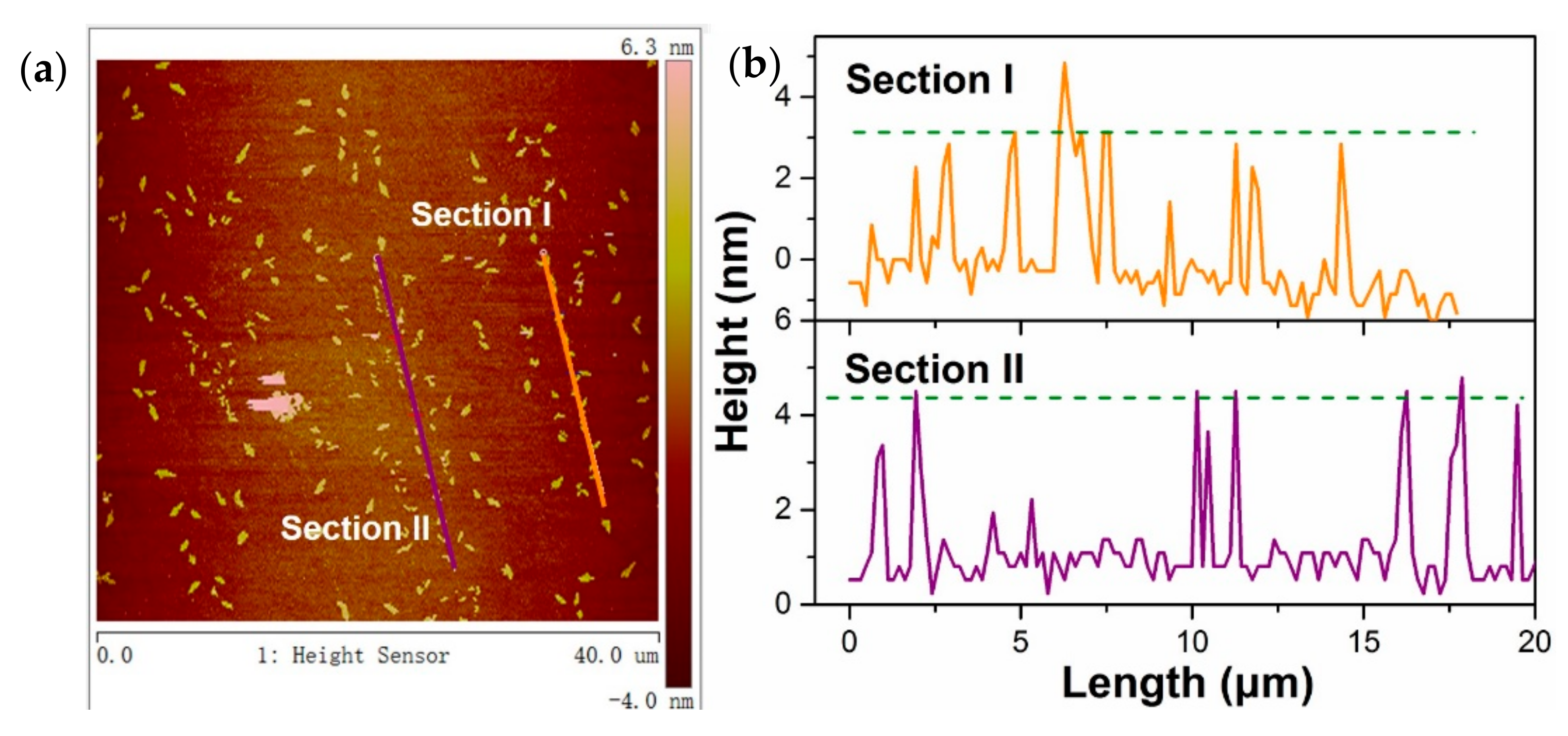
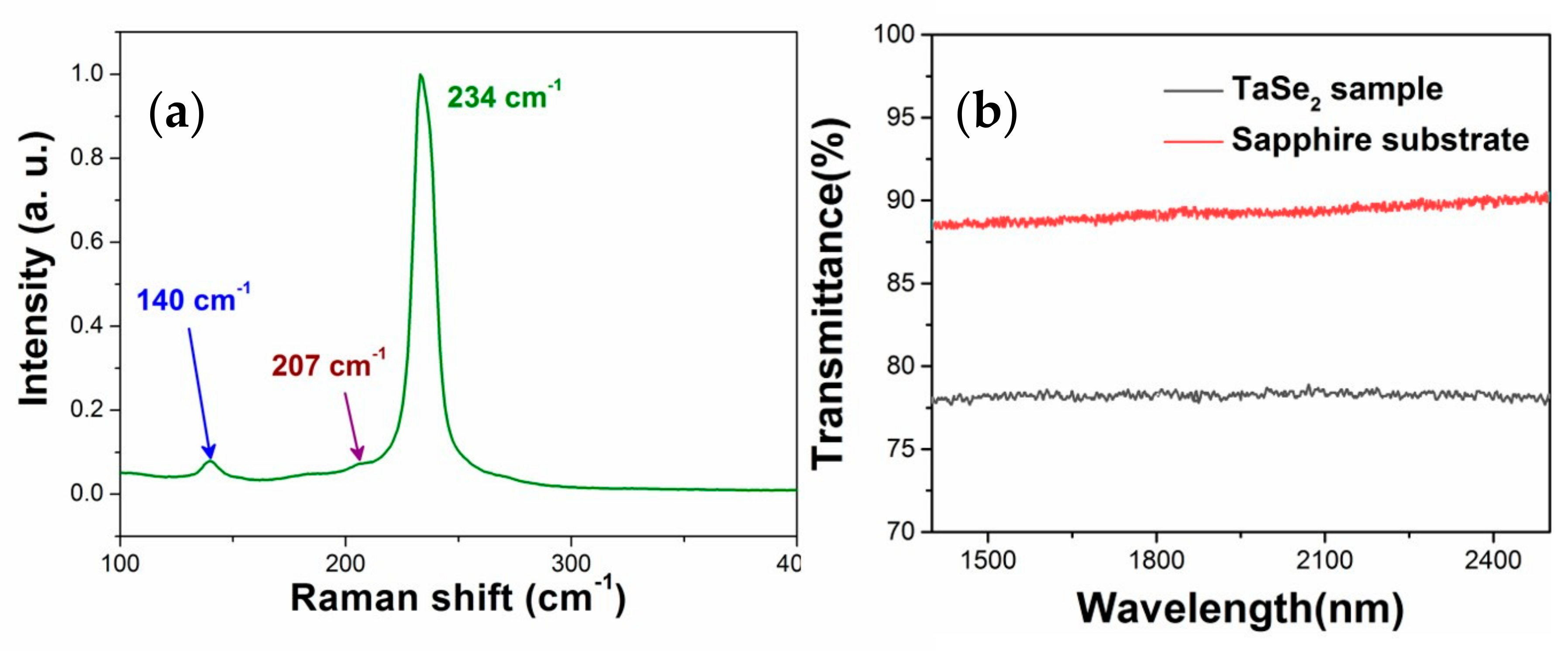

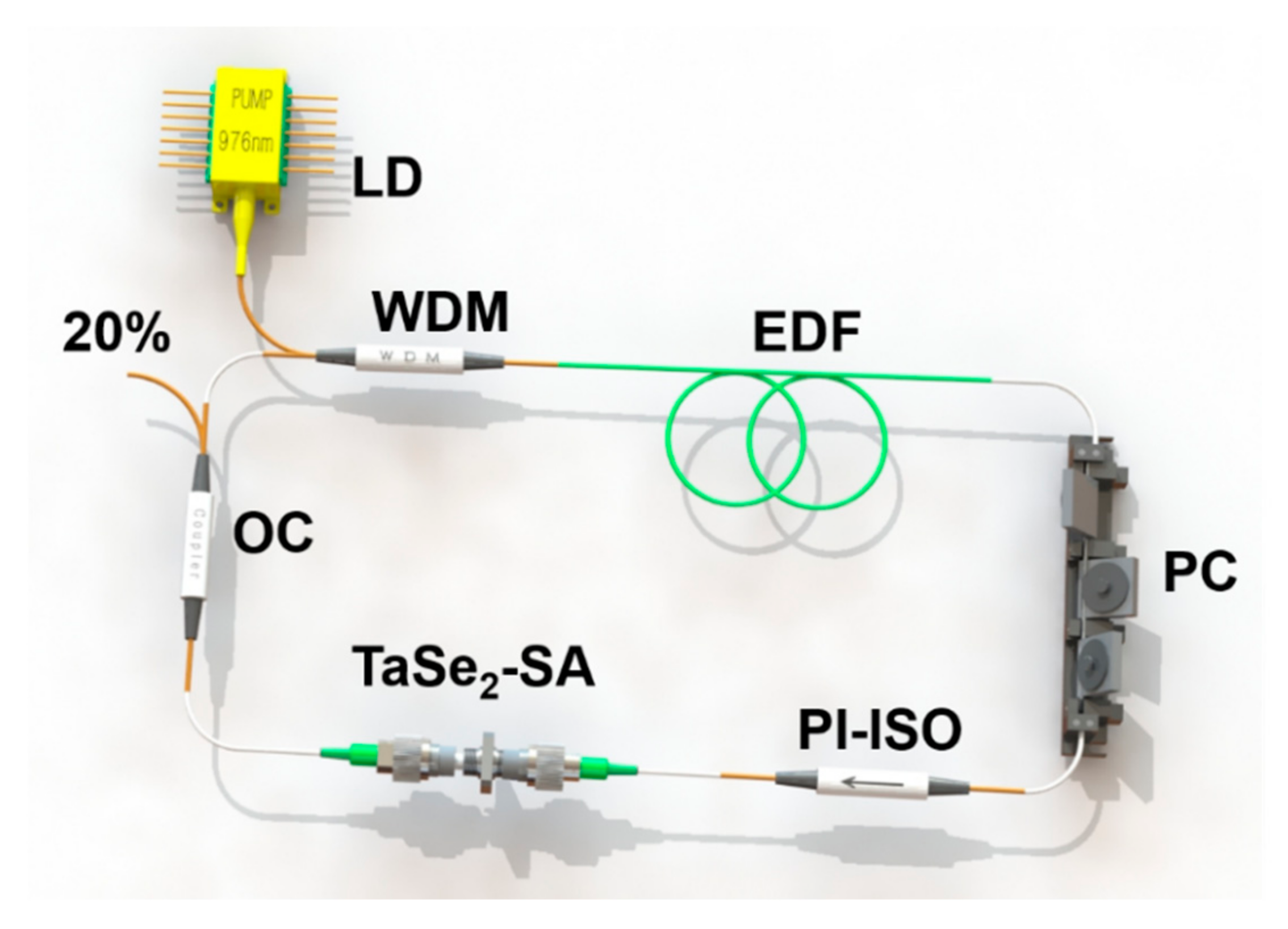
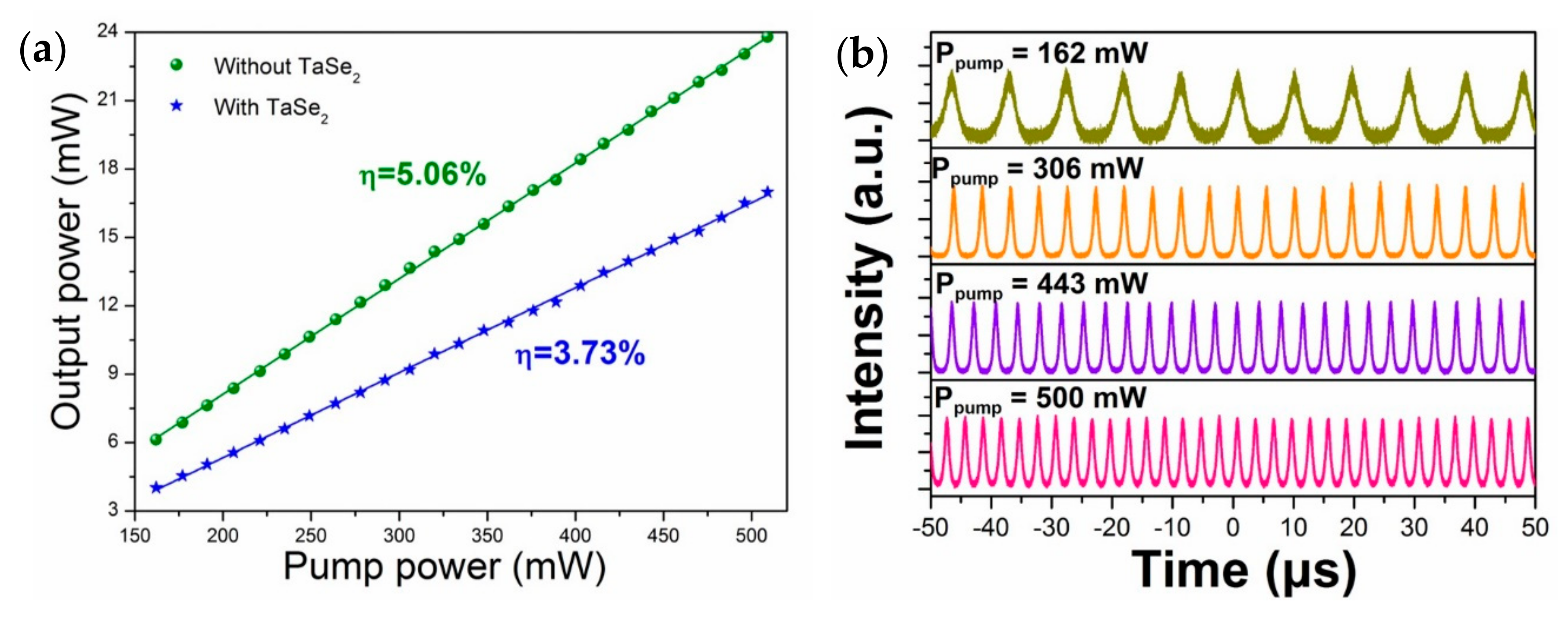

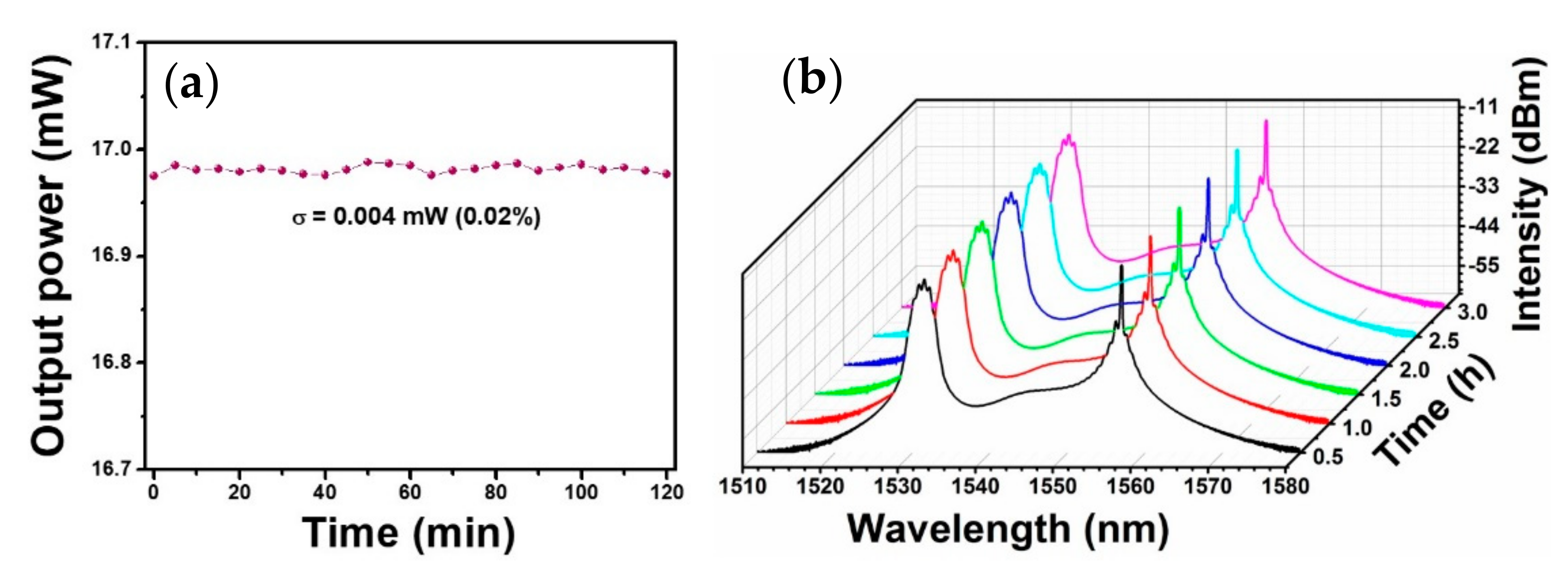
| Materials | Modulation Depth | Saturation Intensity | Minimum Pulse Width (μs) | Pulse Energy (nJ) | Ref. |
|---|---|---|---|---|---|
| MoS2 | 29% | 4.53 MW/cm2 | 6 | 150 | [35] |
| WS2 | 7.7% | 342.6 MW/cm2 | 0.1549 | 68.5 | [36] |
| MoSe2 | 6.73% | 132.5 MW/cm2 | 4.04 | 365.9 | [37] |
| WSe2 | 7.17% | 7 MW/cm2 | 1 | 29 | [38] |
| MoWSe2 | 19.7% | 18.9 μJ/cm2 | 1.53 | 151.4 | [27] |
| 2H-TaSe2 | 9.6% | 12.7 μJ/cm2 | 2.95 | 188.9 | This work |
Publisher’s Note: MDPI stays neutral with regard to jurisdictional claims in published maps and institutional affiliations. |
© 2021 by the authors. Licensee MDPI, Basel, Switzerland. This article is an open access article distributed under the terms and conditions of the Creative Commons Attribution (CC BY) license (http://creativecommons.org/licenses/by/4.0/).
Share and Cite
Yang, L.; Zhao, R.; Wu, D.; Xu, T.; Liu, X.; Nie, Q.; Dai, S. Metallic 2H-Tantalum Selenide Nanomaterials as Saturable Absorber for Dual-Wavelength Q-Switched Fiber Laser. Sensors 2021, 21, 239. https://doi.org/10.3390/s21010239
Yang L, Zhao R, Wu D, Xu T, Liu X, Nie Q, Dai S. Metallic 2H-Tantalum Selenide Nanomaterials as Saturable Absorber for Dual-Wavelength Q-Switched Fiber Laser. Sensors. 2021; 21(1):239. https://doi.org/10.3390/s21010239
Chicago/Turabian StyleYang, Lingling, Ruwei Zhao, Duanduan Wu, Tianxiang Xu, Xiaobiao Liu, Qiuhua Nie, and Shixun Dai. 2021. "Metallic 2H-Tantalum Selenide Nanomaterials as Saturable Absorber for Dual-Wavelength Q-Switched Fiber Laser" Sensors 21, no. 1: 239. https://doi.org/10.3390/s21010239
APA StyleYang, L., Zhao, R., Wu, D., Xu, T., Liu, X., Nie, Q., & Dai, S. (2021). Metallic 2H-Tantalum Selenide Nanomaterials as Saturable Absorber for Dual-Wavelength Q-Switched Fiber Laser. Sensors, 21(1), 239. https://doi.org/10.3390/s21010239





